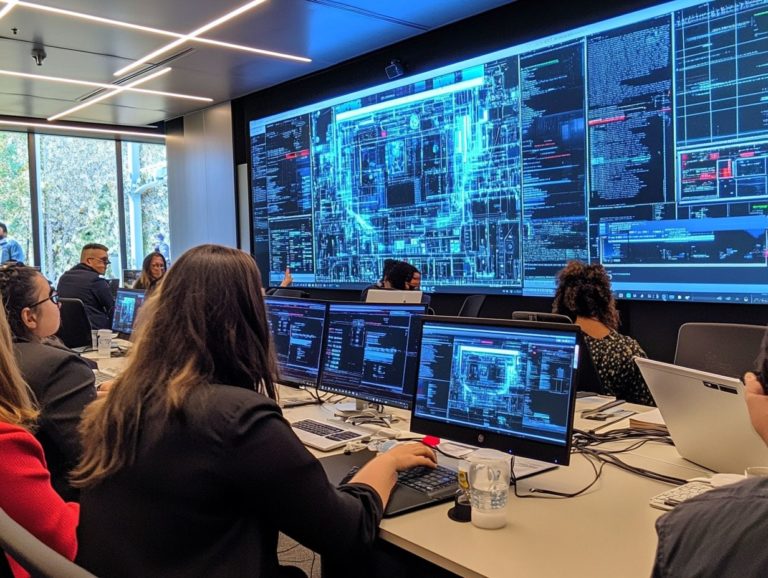the role of gamification in cybersecurity training
In today s digital landscape, where cyber threats are constantly evolving, effective cybersecurity training is absolutely essential to protect your organization. Traditional training methods often miss the mark when it comes to engaging employees, leaving your organization vulnerable to attacks.
Enter gamification: a game-changer that transforms learning into an interactive and enjoyable experience. This article delves into how using game-like elements in learning can revolutionize your cybersecurity training, boosting engagement through realistic simulations and hands-on practice.
You ll discover successful implementations, best practices for design, and the promising future of gamified training in the ongoing battle against cyber threats.
Contents
- Key Takeaways:
- The Importance of Cybersecurity Training
- How Gamification Can Enhance Cybersecurity Training
- Examples of Gamification in Cybersecurity Training
- Best Practices for Incorporating Gamification in Cybersecurity Training
- Future Implications and Potential for Gamification in Cybersecurity Training
Key Takeaways:
- Gamification enhances cybersecurity training by providing an engaging and interactive learning experience.
- Realistic simulations and hands-on practice can better prepare individuals for real-life cyber attacks.
- Incorporating gamification in cybersecurity training requires careful consideration and design to ensure effectiveness.

Defining Gamification and Its Applications in Cybersecurity
Gamification involves applying game mechanics and design techniques in non-gaming settings, especially to boost engagement and motivation in areas like cybersecurity. Organizations are increasingly turning to gamification strategies to tackle cybersecurity challenges, elevate security awareness, and cultivate critical thinking skills among cybersecurity professionals.
By employing gamified simulations and real-world scenarios, companies can create engaging training experiences designed to build essential cybersecurity skills and promote ongoing training among employees. This approach captures attention and helps build a strong security culture within organizations.
For example, some companies introduce competitive training modules where employees can earn points or badges for completing security tasks, significantly ramping up engagement levels. These methods enhance learning retention by incorporating repetition in a fun context, helping staff remember vital information related to cybersecurity threats.
Scenario-based challenges that require problem-solving can sharpen critical thinking skills, ensuring that employees are well-equipped to respond effectively to real-world cybersecurity incidents.
The Importance of Cybersecurity Training
Cybersecurity training is essential for organizations aiming to protect their digital assets. In an era where cyber threats are on the rise, equipping your employees with the skills needed to navigate complex security landscapes has become crucial.
As cybercriminals become more sophisticated, ongoing training transforms into a necessity, helping you cultivate critical cybersecurity skills and develop a robust security culture within your organization. The best training programs focus on hands-on experiences and real-world scenarios, ensuring that your employees are not just prepared, but ready to tackle a variety of cybersecurity challenges head-on.
The Risks of Insufficient Training

Insufficient cybersecurity training presents significant risks for organizations. When employees aren t adequately prepared to confront cybersecurity threats, they become easy targets for phishing attacks and other vulnerabilities that can jeopardize data integrity and security.
This lack of readiness can lead to negative consequences, including financial losses and a tarnished reputation that takes years to restore. When employees struggle to recognize common tactics used by cybercriminals like fake emails or deceptive links the likelihood of unintentionally compromising sensitive information increases dramatically.
Inadequate training results in a workforce that lacks the skills necessary to develop effective strategies for mitigating risks, contributing to a reactive approach to security instead of a proactive one. Consequently, the organization finds itself trapped in a cycle of vulnerability and exposure, ultimately weakening its overall resilience against future threats.
Don t wait! Start enhancing your cybersecurity training today.
How Gamification Can Enhance Cybersecurity Training
Gamification has the potential to elevate your cybersecurity training dramatically, transforming conventional learning experiences into captivating and interactive environments that engage employees and enhance their cybersecurity skills.
By integrating game mechanics like friendly competition and enticing incentives for participation you can inspire employees to immerse themselves in their learning journey while fostering a culture of continuous training.
This strategy boosts knowledge retention and ignites genuine enthusiasm for exploring cybersecurity challenges and best practices.
Engaging and Interactive Learning Experience
An engaging and interactive learning experience is essential for effective cybersecurity training, significantly influencing your motivation and the likelihood of lasting behavioral change.
Incorporating gamified simulations allows organizations to dive into realistic attack scenarios that test your critical thinking and problem-solving abilities, ultimately sharpening your skills to tackle real-world threats.
This hands-on approach makes learning fun and exciting while reinforcing the critical importance of cybersecurity awareness.
Through these interactive platforms, you can witness the immediate consequences of your actions, fostering a deeper understanding of both the associated risks and the effective countermeasures.
This shift toward experiential learning creates an environment where you feel enabled to translate theoretical knowledge into practical applications.
Such immersive experiences boost retention rates and nurture a culture of continuous improvement and adaptability traits vital for navigating the ever-changing landscape of cyber threats.
As you engage in collaborative problem-solving, you’ll naturally hone your teamwork skills, crucial for incident response scenarios and overall organizational resilience.
Realistic Simulations and Hands-on Practice

Engaging in realistic simulations and hands-on practice during cybersecurity training offers invaluable experiences that help develop and refine your cybersecurity skills in a controlled environment.
By exposing you to various attack scenarios, organizations can develop important problem-solving skills and promote effective teamwork when responding to potential security threats.
This practical approach enhances your individual proficiency and reinforces a collective security culture that is crucial for organizational resilience.
These immersive training methodologies prepare you to tackle known vulnerabilities while equipping you with the agility to counter emerging threats, ensuring that you remain a step ahead of potential cyber adversaries.
By fostering an environment where you can learn from simulated breaches and engage in collaborative strategizing, organizations significantly improve response times during actual incidents.
Emphasizing real-world attack simulations boosts your confidence and supports the development of critical communication skills, ultimately strengthening the overall security posture of the organization.
Examples of Gamification in Cybersecurity Training
Numerous organizations are successfully using gamification in their cybersecurity training programs, achieving remarkable results in tackling cybersecurity challenges and boosting employee engagement.
For example, hackathons and Capture the Flag (CTF) competitions have become popular gamified training formats that promote participation and cultivate collaboration and knowledge sharing among employees.
By examining case studies of these successful implementations, you can uncover valuable insights into the effectiveness of gamified training approaches.
Explore how you can implement these strategies in your organization today!
Case Studies of Successful Implementations
Several compelling case studies illustrate how effectively gamification enhances cybersecurity training, showcasing notable improvements in employee engagement and skills development.
Organizations like AwareGO and Hoxhunt seamlessly integrate gamified strategies into their training programs, leading to impressive gains in security awareness and a significant reduction in cyber threat risks.
Events like the annual Defcon highlight innovative training techniques that prioritize collaboration and critical thinking.
Utilizing AwareGO’s interactive training modules, companies report up to a 30% boost in employee retention of essential security protocols. Hoxhunt turns real-life phishing attacks into engaging games, resulting in a remarkable 60% decrease in participants’ susceptibility to phishing attempts.
These organizations leverage blended learning strategies incorporating competition, real-time feedback, and recognition, contributing to a robust culture of security awareness.
The success of these approaches underscores the critical role of employee engagement in tackling cybersecurity challenges and points to the ongoing potential for enhancing security practices across various enterprises.
Best Practices for Incorporating Gamification in Cybersecurity Training

Incorporating gamification into cybersecurity training requires embracing best practices that enhance program effectiveness and cultivate a culture of continuous learning.
Leverage user-centered design principles to craft tailored experiences that resonate with employees and boost their motivation to engage.
Introduce incentives for participation to significantly elevate engagement levels and enrich the overall training experience.
Considerations for Designing Effective Gamified Training Programs
Effective gamified training programs demand meticulous design considerations focused on employee engagement and learning outcomes.
By harnessing personalized training that adapts to individual learning styles, you can ensure that each employee remains motivated and challenged throughout the process.
Incorporating mechanisms for positive reinforcement elevates the learning experience, fostering meaningful behavioral changes and enhancing cybersecurity skills.
These innovative training strategies create a supportive environment as you tackle new challenges. Personalized feedback and reachable rewards develop your sense of accomplishment, encouraging you to set even higher benchmarks.
This approach enables organizations to continuously assess your progress, allowing for necessary adjustments to maximize retention and application of knowledge.
Ultimately, integrating adaptive methodologies and reinforcement techniques boosts your engagement and empowers you to take ownership of your learning journey, leading to sustained performance improvements over time.
Future Implications and Potential for Gamification in Cybersecurity Training
The future of gamification in cybersecurity training looks incredibly bright and full of opportunities, especially as technological advancements elevate immersive learning experiences for employees like you.
Integrating virtual reality and augmented reality tools allows organizations to craft engaging training environments that mirror real-world cybersecurity challenges.
This evolving potential of gamification highlights its critical role in nurturing a skilled cybersecurity workforce ready to tackle emerging threats effectively.
Explore these strategies today to enhance your cybersecurity training programs!
Advancements in Technology and Adaptability of Gamification
Advancements in technology will elevate your experience with gamification in cybersecurity training. This creates engaging learning that connects with employees.
By using virtual reality and simulations, you can build environments that mimic real-world cyber threats. Participants can engage hands-on with scenarios they may face in their roles.
These immersive techniques keep you motivated and encourage teamwork. You and your colleagues can tackle complex challenges together.
Platforms hosting online competitions and Capture The Flag (CTF) events provide a competitive edge. They allow cybersecurity professionals to assess and enhance their skills in an engaging way.
This exciting approach fosters a vibrant culture of ongoing learning. It equips your teams to tackle the ever-evolving landscape of cyber threats.






